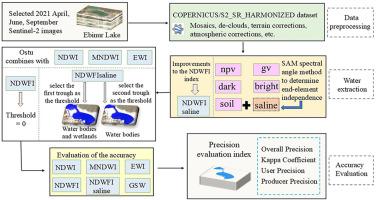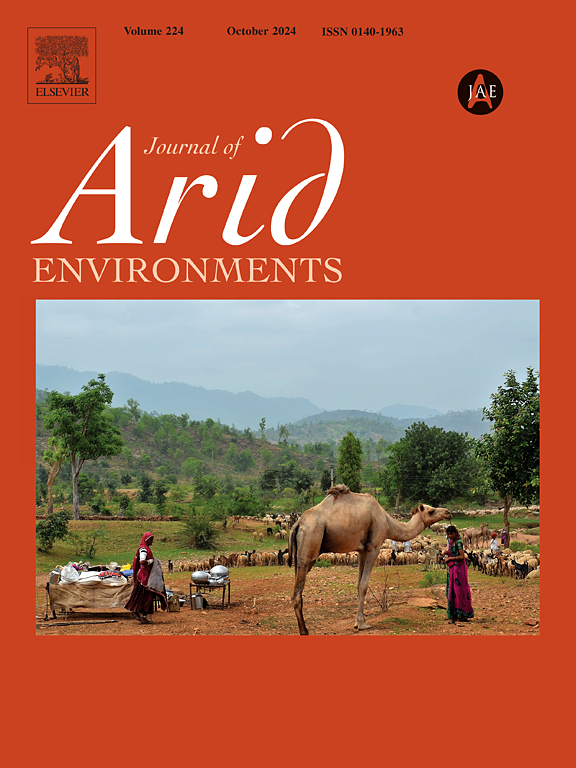基于盐端元约束的干旱区湖泊制图动态阈值优化
IF 2.5
3区 环境科学与生态学
Q2 ECOLOGY
引用次数: 0
摘要
干旱地区的末端湖泊由于干旱气候和人类取水而具有较大的盐碱区。在实际应用中,盐碱区的光谱特征容易与水体相混淆,因此准确识别水体边界对水资源管理、湿地保护和干旱监测具有重要意义。本研究以艾比努尔湖为例,将盐水端元纳入归一化差水分数指数(NDWFI)框架,构建了新的水指数NDWFIsaline。设置动态阈值,区分水体和咸水湿地。同时,利用归一化差水指数(NDWI)、修正归一化差水指数(MNDWI)、增强水指数(EWI)和NDWFI对水体进行提取。结果表明,NDWFIsaline指数在不同季节均表现出优异的准确性(97%以上),Kappa系数均超过0.94。相比之下,在相同盐度条件下,现有水指数表现稍差且变化较大:NDWI、EWI和NDWFI精度在87% ~ 98%之间,Kappa值约为0.61 ~ 0.92;MNDWI准确率持续低于89%,Kappa系数保持在0.75以下。与全球地表水(GSW)产品相比,NDWFIsaline指数显示泄漏率降低了约2%,误分类率显著降低了约28%。NDWFIsaline对盐碱地的光谱干扰具有独特的抵抗力,可以在盐碱地广泛分布的干旱地区进行精确的水制图。本文章由计算机程序翻译,如有差异,请以英文原文为准。

Optimizing dynamic thresholds with salt endmember constraints for lake mapping in arid regions
Arid-region terminal lakes have large saline areas present due to the arid climate and human water extraction. In practical applications, the spectral characteristics of saline areas are easily confused with water bodies, so accurate identification of water body boundaries is of great significance for water resource management, wetland protection, and drought monitoring. In this study, using Ebinur Lake as an example, a novel water index named NDWFIsaline was developed by incorporating a saline endmember into the Normalized Difference Water Fraction Index (NDWFI) framework. A dynamic threshold is set to differentiate between the water body and the saline wetland. Meanwhile, this study utilized normalized difference water index (NDWI), modified normalized difference water index (MNDWI), Enhanced Water Index (EWI), and NDWFI to extract the water bodies. Results indicate that the NDWFIsaline index demonstrated outstanding performance, consistently achieving the highest accuracy (exceeding 97 %) across different seasons, with Kappa coefficients all surpassing 0.94. In contrast, under identical salinity conditions, existing water indices showed slightly inferior and more variable performance: NDWI, EWI, and NDWFI accuracy ranged between 87 % and 98 %, with Kappa values approximately 0.61–0.92; MNDWI accuracy consistently fell below 89 %, and its Kappa coefficient remained below 0.75. Compared to the Global Surface Water (GSW) product, the NDWFIsaline index exhibits a reduction in the leakage rate of approximately 2 % and a significant decrease in the misclassification rate of about 28 %. NDWFIsaline's unique resistance to spectral interference from saline environments enables precise water mapping in arid regions with widespread saline-alkali land.
求助全文
通过发布文献求助,成功后即可免费获取论文全文。
去求助
来源期刊

Journal of Arid Environments
环境科学-环境科学
CiteScore
5.70
自引率
3.70%
发文量
144
审稿时长
55 days
期刊介绍:
The Journal of Arid Environments is an international journal publishing original scientific and technical research articles on physical, biological and cultural aspects of arid, semi-arid, and desert environments. As a forum of multi-disciplinary and interdisciplinary dialogue it addresses research on all aspects of arid environments and their past, present and future use.
 求助内容:
求助内容: 应助结果提醒方式:
应助结果提醒方式:


